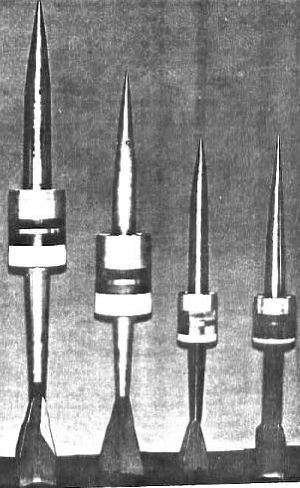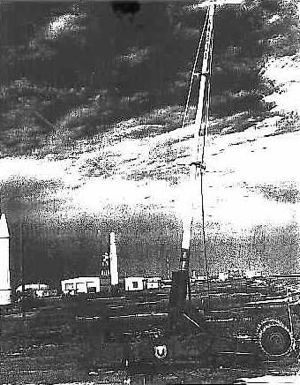
Home - Search - Browse - Alphabetic Index: 0- 1- 2- 3- 4- 5- 6- 7- 8- 9
A- B- C- D- E- F- G- H- I- J- K- L- M- N- O- P- Q- R- S- T- U- V- W- X- Y- Z
HARP 5-3
 HARP 7 & 5 in probes From left to right: HARP 7-1, 7-2, 5-1, and 5-3. |
Status: Study 1960. Payload: 0.90 kg (1.98 lb). Gross mass: 10 kg (23 lb). Height: 1.16 m (3.80 ft). Span: 0.13 m (0.42 ft).
Although simple in design, the components which made up the nose eject system of the 5-1 probe constituted a considerable portion of the 5-1 probes manufacturing resources. To simplify the manufacturing of the 5 inch probes a new probe design was considered that replaced the 5-1 tapered boat tail with a straight tail and permitted payloads to be ejected out the rear of the projectile at altitudes of up to 61 km.
The 5-3 probe retained the general characteristics of its predecessors with a flight weight of 10.4 kg, a major diameter of 66 mm and an over length of 116 cm. The forward body retained the same general shape as the 5-1 and it used the same sabotry. The tail boom of the 5-3 probe was significantly modified, with a straight tail boom and 6 fins (versus the 4 finned tapered tail boom of the 5-1). This straight tail boom was hollow and provided a payload chamber that ran nearly half of the length of the probe's body.
The payload ejection profile for the 5-3 was simplified as well. To prevent gun gases from entering the probe's rear payload compartment during launching the base of the tail boom was fitted with a simple shouldered plug. This plug used O-ring seals to prevent entry of gun gases and had a slightly oversized lip which allowed aerodynamic forces to blow the plug off of the probe body after launch. After the base plug was separated the payload would be retained by small shear pins. At launch a single mechanical fuse would be activated. This was similar to the 5-1 probe, but instead of using a pyrotechnic charge to eject the payload, the timer would break the seal on a small CO2 cartridge which would pressurize the compartment and force the payload out.
The rear ejection technique of the 5-3 probe was a very successful method of deploying payloads without the complexities of the 5-1 probe. The design of the 5-3 was not without its disadvantages. The straight tail boom of the 5-3 exhibited poor aerodynamic characteristics compared to the tapered base of the 5-1. This reduced the 5-3 probe's apogee to only about 61 km (versus the 76 km of the 5-1). The lower altitude of the 5-3 was not considered too much of a concern, at the time. The majority of the flights conducted with the 5-3 were parachuted Metsondes. Above 60 km parachutes provided limited support, so there was no major loss of payload performance.
The 5 inch HARP gun probes were a remarkable successful instruments and some 300 flights were conducted over a 5 year period during HARP. With the main propulsion stage (the gun launcher) being a reusable ground based system the launch costs were in the range of about $300-$500 each flight providing a remarkably low cost launch system, which was more then capable of fulfilling its HARP role.
by Richard K Graf
Family: Atmosphere sat, Earth, Gun-launched, Suborbital. Country: Canada. Launch Vehicles: 5 inch HARP Gun. Agency: Bull.
 | HARP 5 inch Gun |
Back to top of page
Home - Search - Browse - Alphabetic Index: 0- 1- 2- 3- 4- 5- 6- 7- 8- 9
A- B- C- D- E- F- G- H- I- J- K- L- M- N- O- P- Q- R- S- T- U- V- W- X- Y- Z
© 1997-2019 Mark Wade - Contact
© / Conditions for Use